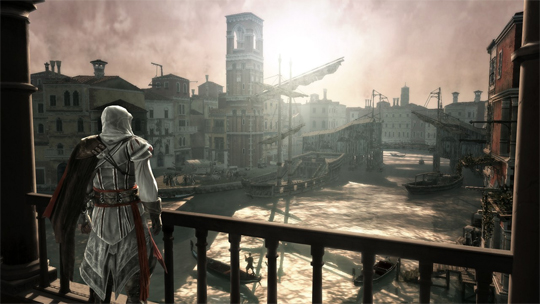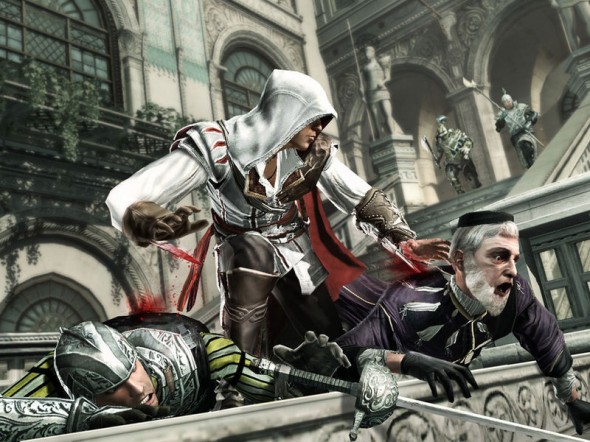Two years ago, I called Assassin’s Creed “the foundation for future games to build upon,” with the potential to be considered among the best games of all time. With Assassin’s Creed II, Ubisoft has taken leaps and bounds that rival Altair’s and Ezio’s own free-running acrobatics, and have created a game to rival most any other that I have had the luxury of experiencing. Assassin’s Creed II is not a work of perfection, but taken as a whole it so satisfyingly delivers upon every aspect first laid out in its prequel, as well as a broad spectrum of new gameplay elements and non-gameplay additions that transcend the medium, that it is difficult to offer anything but praise for this superb title and the development team behind it.
The game is quite clearly a visual masterpiece, rendering the cities of Renaissance Italy in beautiful detail so rich that comparisons to their real-life counterparts yield only minor differences, inside and out. Standing atop the campaniles and church spires treats players to expansive cityscapes, and walking the old-world streets provides a romanticized look at what life (or at least tourism) may have been like at that time. Ezio’s eagle vision very usefully changes all of this to a dark, cloud-covered void, revealing hidden secrets, mission objectives, friends, and foes in bright highlights, and when dealing with the latter, the game’s combat animations, action-camera adjustments, and focal targeting heighten the tension and improve the cinematic experience. It is here, in the midst of such graphical achievement, that my primary complaints about Assassin’s Creed II lie. Screen tearing and shadow pop-in, where nearer shadows are rendered more smoothly than distant ones, are common, and those shadows rendered at lower samples often appear to fluctuate until brought into the higher-quality range. These can be annoying initially, but even so, the effects tend to disappear with prolonged play.

Improvement over time becomes a theme as one plays Assassin’s Creed II; the characters, the plot, the gameplay mechanics, and the player all grow steadily from beginning to end. In doing so, the game’s pace remains as steady or as segmented as the player wishes, because aside from the linear organization of the “memories” that comprise the story, the game features many side missions and personal ambitions for players to partake in. Unlike the previous game, where repetition was unavoidable, only these optional enterprises based on contract assassinations, races, message delivery, et cetera show any signs of monotony, and are all entered into by choice. The assassinations in particular are actually very varied, and can be approached from a number of imaginative angles.
Ezio himself is a solid lead to the finely crafted and intriguing plot. Along with the game’s mechanics, he begins as an unrefined version of what he matures into over the course of roughly 20 hours of play; from a young, rash, untrained hothead, he develops into a skilled, tempered, and discerning assassin. He learns new ways of approaching and eliminating targets, such as leaping from above, ambushing from hiding places, ordering hired groups of thieves or courtesans to distract guards, or swimming below the water’s surface and reaching up onto the deck of a ship to seize his prey. Even the simple act of blending with the crowd has become entirely natural, allowing Ezio to simply walk in and out of groups of people to avoid detection, stopping on benches when moving, human cover becomes unavailable to him.
Ezio also learns to use new weapons through the deciphering of Altair’s lost codices by friend and ally Leonardo da Vinci, and can use money found throughout the cities of northern Italy (and plucked from the pockets of its inhabitants) to purchase new arms and armor, poison vials, dyes for his clothing, and medicine to heal his wounds. Weapons are rated according to their strength, speed, and ability to deflect enemy attacks, and armor improves health and reduces damage, but can be damaged itself, requiring occasional repair at the blacksmith’s shop. These are more than just numbers, and they influence the game’s combat mechanics to varying degrees. Of particular note is the deflection rating, which subtly widens the window of opportunity players have to counter incoming strikes as it improves. Details such as this connect players to the game in a way such that they are sharing in the development of the character and directly benefiting from the newest tools at his disposal, and also motivate the player to continually perfect the art of combat… from the controller end. The game rarely fails to reach out and include players in what is happening within its virtual walls.
The concept of the assassin stronghold returns in Assassin’s Creed II, but unlike the perfunctory existence of Masyaf in Assassin’s Creed, the Auditore Villa is yet another aspect of the sequel that grows by the player’s hand. By building upon the many shops and other, less gameplay-related establishments in the town, its value increases and Ezio is allowed to buy new items at discounted prices. The art shop, which has no ties to the core gameplay but is slyly connected to certain aspects of the conspiracy theory plot, offers up a great many real paintings from the era in question, as well. Feathers found throughout the land and returned to Ezio’s mother earn weapon and outfit rewards, and stone tablets from each of six hidden assassin’s tomb locations in the various cities unlock special armor passed down from Altair himself. It is in these locations that old Ubisoft Montreal fans will find a vary special treat, because the environmental puzzles and swift, organized navigation of interior spaces experienced within mark a return to the Prince of Persia: Sands of Time formula sorely lacking from the newest PoP game, if only for six short — but impressive — segments.

Every aspect of Assassin’s Creed II is seamlessly integrated into the game world and woven into the intricate story about murder, revenge, religious and political corruption, betrayal, and global conspiracy (I’m being deliberately vague in this area, because anyone reading this review should buy the game and experience it for him- or herself). Everything from the menus, to player deaths, to the mixed English and Italian dialog, to subtitles (which display both the spoken Italian and its English translation), to the ability to continue playing after the credits roll, etc. is explained through the story. Perhaps equally impressive is the painstaking detail with which real historic landmarks and personalities are cataloged in a part-fact, part-fiction database. Together with the aforementioned art shops, Assassin’s Creed II uses this extensive database to take itself to a new place, where a videogame can be at least somewhat academically significant in a highly palatable and accessible (and once again, optional) way. It is simultaneously a game, a story, a history lesson, an art gallery, and an architectural archive — no small feat — and it is good at everything it aims to do.
Without even mentioning the minutia of combat and platforming, Assassin’s Creed II is quite an impressive piece of work, and one can rest assured that the game’s “puppeteering” control scheme for free-running across rooftops is smooth and liberating, while its attack, defense, counter, and newly added disarm functions in combat are precise and empowering. In all, Assassin’s Creed II is simply one of the most engaging, enjoyable, rewarding, and complete videogame experiences I’ve ever encountered. My highest honors….

















